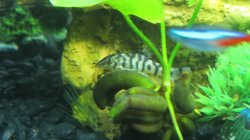kuzyaburst
Fish Fanatic
I was looking at Yo Yo loaches recently and thought they were pretty cool. I've seen many sites that have ranges of the adult size of the loach. I just want to know what is the average size of an adult YoYo Loach? Also what is the amount of loaches recommended for a school? I was thinking of getting 4 or maybe 5, I currently own 2 in my tank that are about 1".


 /www.seriouslyfish.com/species/botia-almorhae/
/www.seriouslyfish.com/species/botia-almorhae/